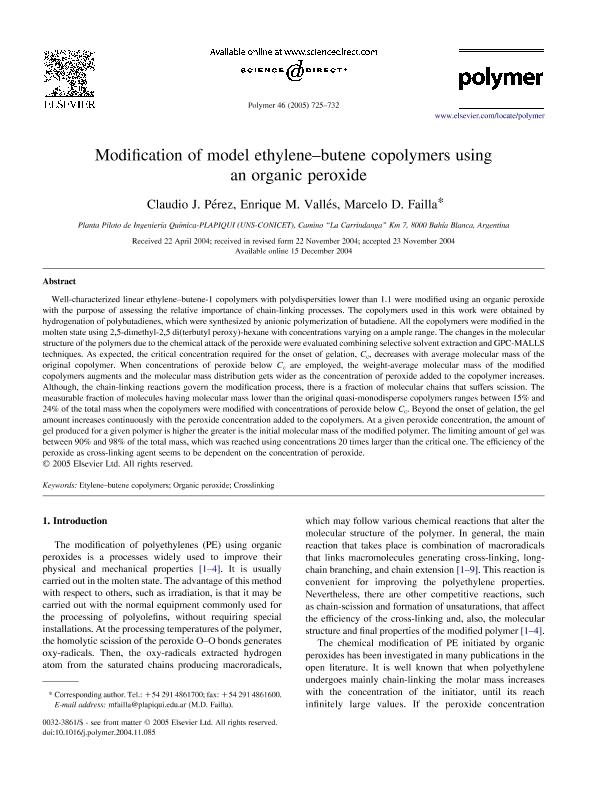Mostrar el registro sencillo del ítem
dc.contributor.author
Pérez, Claudio Javier

dc.contributor.author
Valles, Enrique Marcelo

dc.contributor.author
Failla, Marcelo Daniel

dc.date.available
2019-07-01T20:40:41Z
dc.date.issued
2005-01-26
dc.identifier.citation
Pérez, Claudio Javier; Valles, Enrique Marcelo; Failla, Marcelo Daniel; Modification of model ethylene-butene copolymers using an organic peroxide; Elsevier; Polymer; 46; 3; 26-1-2005; 725-732
dc.identifier.issn
0032-3861
dc.identifier.uri
http://hdl.handle.net/11336/78982
dc.description.abstract
Well-characterized linear ethylene-butene-1 copolymers with polydispersities lower than 1.1 were modified using an organic peroxide with the purpose of assessing the relative importance of chain-linking processes. The copolymers used in this work were obtained by hydrogenation of polybutadienes, which were synthesized by anionic polymerization of butadiene. All the copolymers were modified in the molten state using 2,5-dimethyl-2,5 di(terbutyl peroxy)-hexane with concentrations varying on a ample range. The changes in the molecular structure of the polymers due to the chemical attack of the peroxide were evaluated combining selective solvent extraction and GPC-MALLS techniques. As expected, the critical concentration required for the onset of gelation, Cc, decreases with average molecular mass of the original copolymer. When concentrations of peroxide below Cc are employed, the weight-average molecular mass of the modified copolymers augments and the molecular mass distribution gets wider as the concentration of peroxide added to the copolymer increases. Although, the chain-linking reactions govern the modification process, there is a fraction of molecular chains that suffers scission. The measurable fraction of molecules having molecular mass lower than the original quasi-monodisperse copolymers ranges between 15% and 24% of the total mass when the copolymers were modified with concentrations of peroxide below Cc. Beyond the onset of gelation, the gel amount increases continuously with the peroxide concentration added to the copolymers. At a given peroxide concentration, the amount of gel produced for a given polymer is higher the greater is the initial molecular mass of the modified polymer. The limiting amount of gel was between 90% and 98% of the total mass, which was reached using concentrations 20 times larger than the critical one. The efficiency of the peroxide as cross-linking agent seems to be dependent on the concentration of peroxide.
dc.format
application/pdf
dc.language.iso
eng
dc.publisher
Elsevier

dc.rights
info:eu-repo/semantics/openAccess
dc.rights.uri
https://creativecommons.org/licenses/by-nc-sa/2.5/ar/
dc.subject
Crosslinking
dc.subject
Etylene-Butene Copolymers
dc.subject
Organic Peroxide
dc.subject.classification
Físico-Química, Ciencia de los Polímeros, Electroquímica

dc.subject.classification
Ciencias Químicas

dc.subject.classification
CIENCIAS NATURALES Y EXACTAS

dc.title
Modification of model ethylene-butene copolymers using an organic peroxide
dc.type
info:eu-repo/semantics/article
dc.type
info:ar-repo/semantics/artículo
dc.type
info:eu-repo/semantics/publishedVersion
dc.date.updated
2019-06-11T19:31:54Z
dc.journal.volume
46
dc.journal.number
3
dc.journal.pagination
725-732
dc.journal.pais
Países Bajos

dc.journal.ciudad
Amsterdam
dc.description.fil
Fil: Pérez, Claudio Javier. Consejo Nacional de Investigaciones Científicas y Técnicas. Centro Científico Tecnológico Conicet - Bahía Blanca. Planta Piloto de Ingeniería Química. Universidad Nacional del Sur. Planta Piloto de Ingeniería Química; Argentina
dc.description.fil
Fil: Valles, Enrique Marcelo. Consejo Nacional de Investigaciones Científicas y Técnicas. Centro Científico Tecnológico Conicet - Bahía Blanca. Planta Piloto de Ingeniería Química. Universidad Nacional del Sur. Planta Piloto de Ingeniería Química; Argentina
dc.description.fil
Fil: Failla, Marcelo Daniel. Consejo Nacional de Investigaciones Científicas y Técnicas. Centro Científico Tecnológico Conicet - Bahía Blanca. Planta Piloto de Ingeniería Química. Universidad Nacional del Sur. Planta Piloto de Ingeniería Química; Argentina
dc.journal.title
Polymer

dc.relation.alternativeid
info:eu-repo/semantics/altIdentifier/url/https://www.sciencedirect.com/science/article/pii/S0032386104012145
dc.relation.alternativeid
info:eu-repo/semantics/altIdentifier/doi/http://dx.doi.org/10.1016/j.polymer.2004.11.085
Archivos asociados
